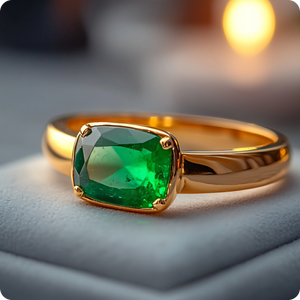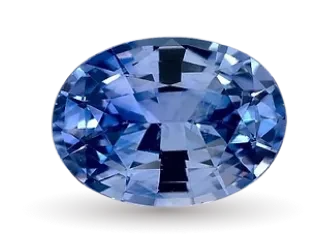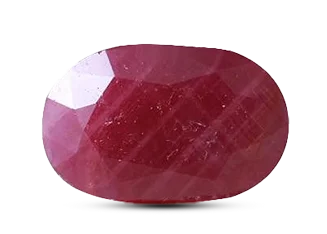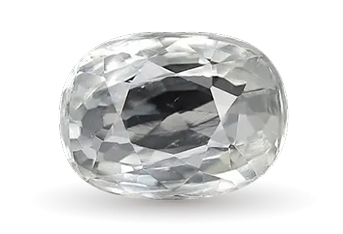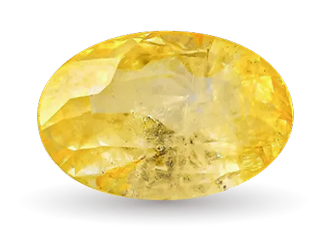It's crucial to know what you're looking for before beginning any gemstone testing. The most prevalent kinds of misrepresentations are as follows:
Synthetic Gemstones
Lab-created stones that replicate the optical, chemical, and physical characteristics of real gems are known as synthetic gemstones. They are not organically generated, despite having a true structure. They are a common but dishonest substitute in the market as they frequently seem perfect and are significantly less expensive than real stones.
Simulants or Imitations
Simulants are look-alike alternatives that merely superficially resemble real diamonds and are constructed of materials like glass, plastic, or cubic zirconia. Their composition and hardness are different from those of synthetics. These are easily damaged, discoloured, or shattered over time, and are frequently offered to unwary purchasers as real stones.
Treated Gemstones
A gemstone's colour or clarity can be improved by using heat treatment. This steady and industry-accepted method is typical in sapphires and rubies. To guarantee openness and help buyers make educated decisions, it is necessary to mention that treated stones are less valued than untreated ones.
Dyeing
In order to improve the appearance of porous or pale stones, such as agate or turquoise, dyeing entails applying artificial colour. Natural imperfections or discolourations may be concealed by this procedure. Compared to natural-colored stones, dyed gemstones are less durable and appealing since they frequently fade over time, particularly when exposed to sunshine or cleaning agents.
Facture Filling
In order to increase clarity, glass or resin is injected into the fissures and cracks of gemstones, particularly diamonds and rubies. Fillers might lessen durability even though they give the stone a cleaner appearance. The buyer should always be informed of these treatments since they have a substantial impact on the stone's value.
Coating
In order to change or improve the appearance of the stone, gemstone coating entails putting a thin layer of coloured material to the surface. It is frequently found in quartz and topaz. Coatings, despite their aesthetic appeal, are transient and prone to wear, which shortens the stone's lifespan and frequently deceives customers about its genuineness.
Basic Gemstone Identification Techniques
Visual inspection, hardness testing, refractive index checks, and density comparisons are examples of basic identifying techniques. Instruments such as refractometers, hardness picks, and a jeweller’s loupe aid in spotting blatant fakes. These methods provide a basic understanding of the genuineness of the gemstone, but they might miss sophisticated treatments or superior imitations. Let’s understand everything in detail.
Visual Inspection
You can check the gemstone for bubbles, colour zoning, surface flaws, and inclusions with a jeweller’s loupe (10x magnification). While replica or synthetic stones frequently appear too perfect, natural stones usually have flaws. Visual cues aid in determining authenticity and spotting overt indications of falsification or enhancement.
Hardness Test
Using the Mohs scale, this test assesses a gemstone's ability to withstand scratches. For instance, sapphire (hardness 9) cannot be scratched by quartz (hardness 7), but diamonds (hardness 10) can. Identity discrepancies may be discovered via hardness testing, particularly in simulants composed of softer materials like glass.
Transparency and Refractive Index
The refractive index (RI), a measurement of how light is bent in natural gemstones, varies. This value can be measured with a refractometer. While imitations may exhibit irregularities, genuine gems have constant RI ranges. Transparency is also beneficial; stones that are too transparent or hazy could be signs of artificial origin or treatment.
Weight and Density
Each gemstone has its own density or specific gravity. Fakes can be identified by weighing a gem in relation to its size. A genuine ruby, for example, will weigh more than a glass replica of the same size. Finding discrepancies in gemstone weight and authenticity can be made easier with the use of an accurate digital scale.

 Emerald (Panna)
Emerald (Panna)
 Ruby (Manik)
Ruby (Manik)
 Yellow Sapphire (Pukhraj)
Yellow Sapphire (Pukhraj)
 Blue Sapphire (Neelam)
Blue Sapphire (Neelam)
 White Sapphire (Safed Pukhraj)
White Sapphire (Safed Pukhraj)
 Hessonite (Gomed)
Hessonite (Gomed)
 Red Coral (Moonga)
Red Coral (Moonga)
 Pearl (Moti)
Pearl (Moti)
 Cats Eye (Lahsuniya)
Cats Eye (Lahsuniya)
 Opal (Dudhiya Pathar)
Opal (Dudhiya Pathar)
 Red Garnet (Rakt Mani)
Red Garnet (Rakt Mani)
 Moonstone (Chandrakant)
Moonstone (Chandrakant)
 Carnelian (Rat-Ratua)
Carnelian (Rat-Ratua)
 Peridot (Mani Stone)
Peridot (Mani Stone)
 Green Onyx (Sulemani)
Green Onyx (Sulemani)
 Jade (Crassula)
Jade (Crassula)
 Citrine (Sunela)
Citrine (Sunela)
 Amethyst (Jamunia)
Amethyst (Jamunia)
 Aries (Mesh)
Aries (Mesh)
 Taurus (Vrushabh)
Taurus (Vrushabh)
 Gemini (Mithun)
Gemini (Mithun)
 Cancer (Kark)
Cancer (Kark)
 Leo (Sinh)
Leo (Sinh)
 Virgo (Kanya)
Virgo (Kanya)
 Libra (Tula)
Libra (Tula)
 Scorpio (Vrishchik)
Scorpio (Vrishchik)
 Sagittarius (Dhanu)
Sagittarius (Dhanu)
 January Birthstone
January Birthstone
 February Birthstone
February Birthstone
 March Birthstone
March Birthstone
 April Birthstone
April Birthstone
 May Birthstone
May Birthstone
 June Birthstone
June Birthstone
 July Birthstone
July Birthstone
 August Birthstone
August Birthstone
 September Birthstone
September Birthstone
 October Birthstone
October Birthstone
 November Birthstone
November Birthstone
 December Birthstone
December Birthstone
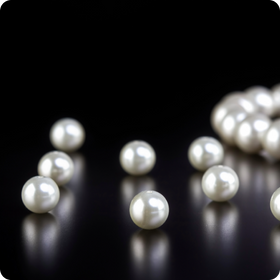
 Emerald Rings
Emerald Rings
 Yellow Sapphire Rings
Yellow Sapphire Rings
 Blue Sapphire Rings
Blue Sapphire Rings
 Ruby Rings
Ruby Rings
 Red Coral Rings
Red Coral Rings
 Pearl Ring
Pearl Ring
 White Sapphire Ring
White Sapphire Ring
 Amethyst Ring
Amethyst Ring
 Aquamarine Ring
Aquamarine Ring
 Blue Topaz Ring
Blue Topaz Ring
 Silver Jewellery
Silver Jewellery
 Gold Jewellery
Gold Jewellery
 Panchdhatu Jewellery
Panchdhatu Jewellery
 Rose Gold Jewellery
Rose Gold Jewellery
 Platinum Jewellery
Platinum Jewellery

